The Core i7 980X Review: Intel's First 6-Core Desktop CPU
by Anand Lal Shimpi on March 11, 2010 12:00 AM EST- Posted in
- CPUs
It’s rare that anything we review has the longevity that Intel’s Core i7 Bloomfield platform has enjoyed. If you were one of the fortunate few to buy a Core i7 920, 940 or 965 back in November 2008, you’d still have one of the fastest desktop CPUs today in March 2010.
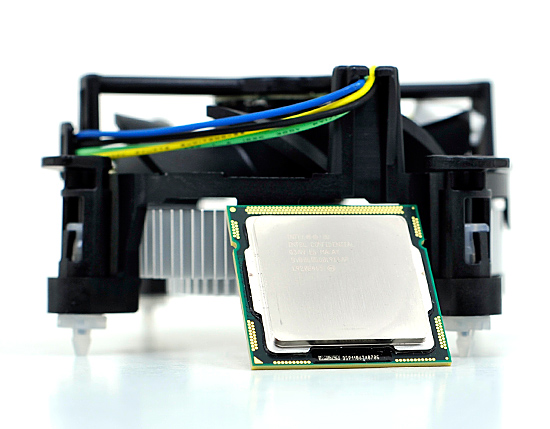
Lynnfield was introduced in 2009, but still couldn't dethrone Bloomfield.
In fact, other than a few minor speed bumps, Intel hasn’t done much with its LGA-1366 platform in the past 15 months. Last year Intel introduced Nehalem for the rest of us with its LGA-1156 socket and in January we got the first dual-core derivatives.
Now it’s finally time to take care of the folks who invested in Nehalem and Core i7 early on. In the coming weeks Intel will be shipping its first 6-core desktop processor, built using the same 32nm process used in the Clarkdale Core i3/i5 CPUs. It’s codenamed Gulftown but today we can call it the Core i7 980X. Did I mention that with a BIOS update it’s fully compatible with all X58 motherboards? That’s right, even if you bought a board in November 2008 - you can upgrade directly to Gulftown.
| Processor | Core Clock | Cores / Threads | L3 Cache | Max Turbo | TDP | Price |
| Intel Core i7 980X | 3.33GHz | 6 / 12 | 12MB | 3.60GHz | 130W | $999 |
| Intel Core i7 975 | 3.33GHz | 4 / 8 | 8MB | 3.60GHz | 130W | $999 |
| Intel Core i7 960 | 3.20GHz | 4 / 8 | 8MB | 3.46GHz | 130W | $562 |
| Intel Core i7 930 | 2.80GHz | 4 / 8 | 8MB | 3.06GHz | 130W | $284 |
| Intel Core i7 870 | 2.93GHz | 4 / 8 | 8MB | 3.60GHz | 95W | $562 |
| Intel Core i7 860 | 2.80GHz | 4 / 8 | 8MB | 3.46GHz | 95W | $284 |
| Intel Core i5 750 | 2.66GHz | 4 / 4 | 8MB | 3.20GHz | 95W | $196 |
| Intel Core i5 670 | 3.46GHz | 2 / 4 | 4MB | 3.73GHz | 73W | $284 |
| Intel Core i5 661 | 3.33GHz | 2 / 4 | 4MB | 3.60GHz | 87W | $196 |
| Intel Core i5 660 | 3.33GHz | 2 / 4 | 4MB | 3.60GHz | 73W | $196 |
| Intel Core i5 650 | 3.20GHz | 2 / 4 | 4MB | 3.46GHz | 73W | $176 |
| Intel Core i3 540 | 3.06GHz | 2 / 4 | 4MB | N/A | 73W | $133 |
| Intel Core i3 530 | 2.93GHz | 2 / 4 | 4MB | N/A | 73W | $113 |
| Intel Pentium G9650 | 2.80GHz | 2 / 2 | 3MB | N/A | 73W | $87 |
The Entire 2010 Nehalem/Westmere lineup
In fact, that’s exactly what I did for today’s review. This is Intel’s DX58SO motherboard I used in my original Core i7 review in November 2008:
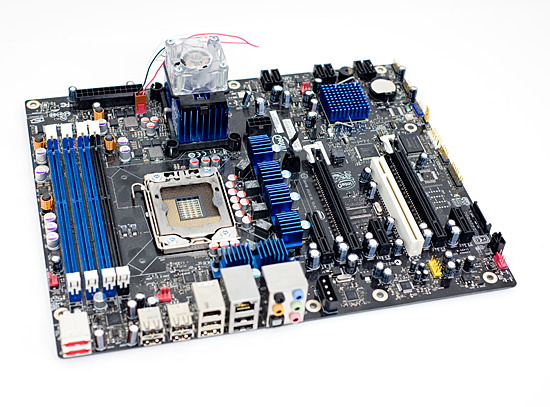
It’s the same exact board, but updated to the 5020 BIOS that’s currently available on Intel’s site. Intel was sneaky and actually enabled Gulftown support in its motherboards a few weeks ago.
And here we have the result:
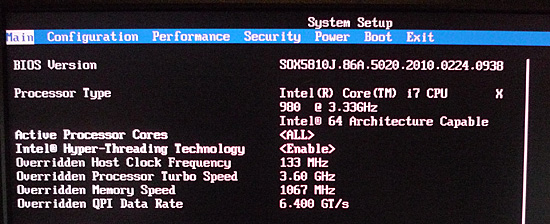
Intel’s Core i7 980X, running at 3.33GHz with 6 cores, 12 threads and a massive 12MB L3 cache all running on a motherboard that shipped a year and a half ago.

The old board works mostly fine with the 980X but with some odd bugs and quirks that I ran into. I found that my older DDR3-1066 memory wouldn't overclock to 1333MHz with Gulftown, although it did just fine with Bloomfield for some reason.
It’s not just Intel enabling support either. All motherboard manufacturers either have or are expected to have BIOSes with Gulftown support by the time this chip ships in the coming weeks. ASRock sent over its X58 Extreme, which worked perfectly with the new chip:

It’s Extreme
The coolest part of Gulftown is that by building it on Intel’s 32nm process it’s actually smaller than both Bloomfield and Lynnfield, despite having 50% more cores and L3 cache:
| CPU | Codename | Manufacturing Process | Cores | Transistor Count | Die Size |
| Westmere 6C | Gulftown | 32nm | 6 | 1.17B | 240mm2 |
| Nehalem 4C | Bloomfield | 45nm | 4 | 731M | 263mm2 |
| Nehalem 4C | Lynnfield | 45nm | 4 | 774M | 296mm2 |
| Westmere 2C | Clarkdale | 32nm | 2 | 384M | 81mm2 |
| AMD Phenom II X4 | Deneb | 45nm | 4 | 758M | 258mm2 |
At 1.17 billion transistors, it’s a beefy chip but the monolithic die only measures 240mm^2. It’s even smaller than an AMD Phenom II X4. Not only does it have a smaller die than all quad-core Nehalem processors, but it also has the same TDP.
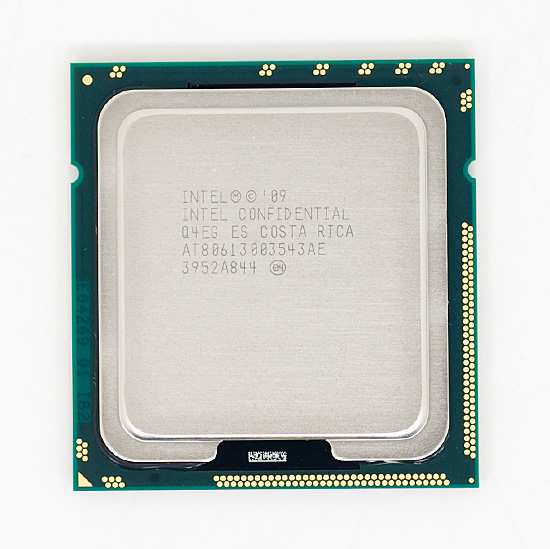
The 130W chip runs at 3.33GHz, but because of the high TDP it can only turbo up to 3.46GHz with more than two cores active. If only one or two cores are active, the chip can turbo up to 3.60GHz. With up to 6 cores running at 3.46GHz, Gulftown is not only the fastest CPU in Intel’s lineup, it’s also the fastest quad-core Intel makes. Only the Core i5 670 can run at a higher frequency with a single core active (3.73GHz vs 3.60GHz).
The downside to all of this is the price tag. The Core i7 980X is an Extreme Edition processor, meaning it’s introduced at the $999 price point. And currently it’s the only way to get 6-cores in a Core i7. Currently Intel doesn't have any plans to introduce 4-core versions of Gulftown on the desktop, although we will see some 32nm quad-core Xeons later this year.
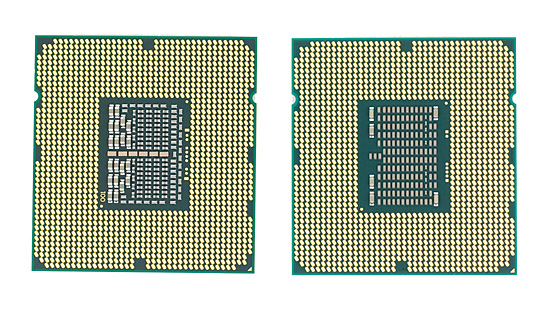
Bloomfield (left) vs. Gulftown (right)
This isn’t the first time that the $999 price tag comes with some exclusive features. The first Pentium 4 Extreme Edition was the very first to wear the EE brand. While all regular Pentium 4s at the time had a 512KB L2, the Pentium 4 Extreme Edition added a 2MB L3 cache - a feature that never trickled down to the mainstream P4s.
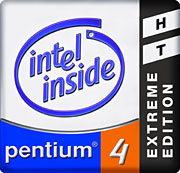
Since then, most Extreme Edition parts have just been higher clocked CPUs. Despite that, they do sell well enough for Intel to continue the practice. Given that this time around, the Core i7 980X will not only give you clock speed but more cores and cache, Intel will probably end up selling more of these than they ever have.










102 Comments
View All Comments
cactusdog - Thursday, March 11, 2010 - link
This wont be the only i7 6 core desktop CPU. Intel are being sneaky to milk the market. There will be another one or possibly 2 at mainstream prices. The cheapest Xeon gulftown is only $400 (2.26Ghz) so why would Intel ignore desktop when X58 boards will happily run a Xeon?GourdFreeMan - Thursday, March 11, 2010 - link
That strategy could just as well backfire on Intel. If you have to wait six months for the other hexacore desktop Gulftowns, you might as well forgo Gulftown entirely and wait a year to fifteen months for hexa/octocore Sandy Bridge. The new AVX instructions in Sandy Bridge are likely to have a far broader impact on performance in terms of software anyway...Triple Omega - Thursday, March 11, 2010 - link
Well I hope you're right. As right now it looks like even Sandy Bridge releasing at least 26 months after the 920 will still have only 4 cores maximum. Not much of a replacement.Also, did anyone notice they broke their own Moore's-Law rule? The 980X only has 1,6 times the transistors of it's predecessor.
DrMrLordX - Friday, March 12, 2010 - link
As I posted above:http://en.wikipedia.org/wiki/List_of_future_Intel_...">http://en.wikipedia.org/wiki/List_of_fu...rocessor...
JumpingJack - Thursday, March 11, 2010 - link
"Also, did anyone notice they broke their own Moore's-Law rule? The 980X only has 1,6 times the transistors of it's predecessor. "You have a fundamental misunderstanding of Moore's Law, this is not unexpected because it is often misquoted or misrepresented in the less technically oriented press. The proper way to state Moore's law is the transistor count will double roughly every two years for the same die size, or for the same transistor count the die size will half. Yet the best way is to simply say the transistor density (transistor/unit area) will double.
You can check the 32 nm adherence to Moore's law by following up on the technical presentations that float around the web, Intel published their IEDM 2009 32 nm stuff:
Also, did anyone notice they broke their own Moore's-Law rule? The 980X only has 1,6 times the transistors of it's predecessor.
http://download.intel.com/technology/architecture-...">http://download.intel.com/technology/ar...-silicon...
See the scaling for gate pitch or SRAM cell size slides 5 and 6, they are clearly falling right on the Moore's law path.
This is not by accident, a linear scaling factor of 0.7 when squared is 0.49 or roughly 0.5 i.e. half the area, this factor is chosen to get double the transistor density each technology node.
talonz - Thursday, March 11, 2010 - link
"Moore's Law" refers to density, not actual transistor count. Anyone can build a big chip.tterremmotto - Thursday, March 11, 2010 - link
Actually, Moore's law has nothing to do with density nor speed. It was about price.Moore's "observation" simply stated that the price per transistor halves every 18 moths. Wether that is due to density increases or process advancement is not a necessity.
Never an observation has been so misunderstood, and yet have such a fantastic side effect.
JKflipflop98 - Thursday, March 11, 2010 - link
Actually, Moore's law is all about transistor density. I know. I see it everyday in the halls, in the elevator, at my desk, in the cleanroom. . .JumpingJack - Thursday, March 11, 2010 - link
He has a small point, Moores Law is just an obseravtion of the rate of shrinkage over time, the phenomena is driven by the economy of scale.Jack
softdrinkviking - Thursday, March 11, 2010 - link
where are you getting your xeon pricing info from?all i can find from any solid source is the current xeon quad core processors which are running about $2000 on newegg at the moment.
xeons have always carried a premium for the intel dual processor support, and imho, a cheaper xeon is going to be more "enterprise" oriented and not be a real upgrade for the home x58 platform.
again, this is pure speculation, but i think we are going to be stuck with our current i7 stuff until intel decides to do a 32 nm refresh on the home line up.
basically, what i'm trying to say is that i think any xeon capable of creaming an i7 930 is going to be WAY more expensive than the 980x gulftown on display here.